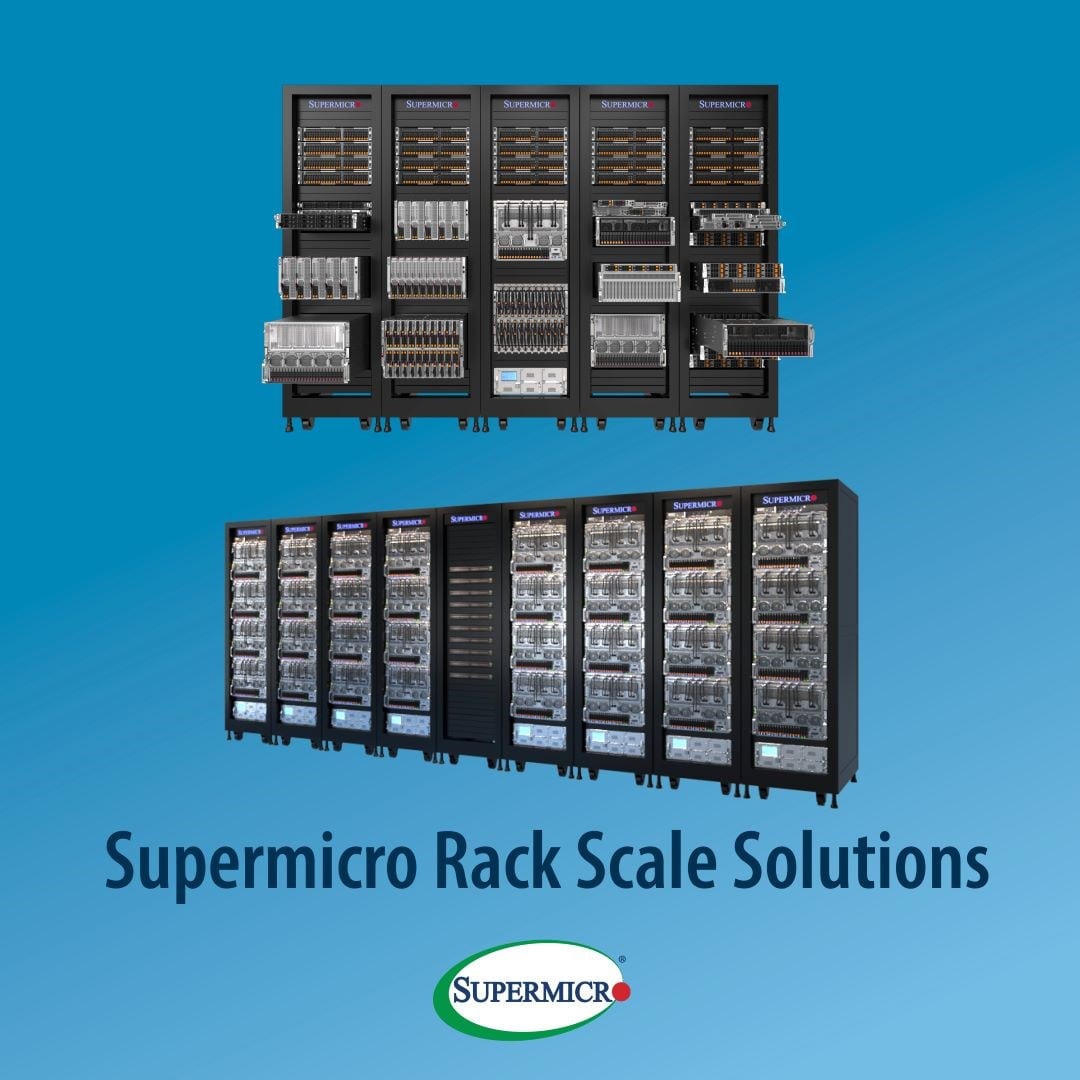5 Gründe, Supermicro für Ihre HPC-Infrastruktur zu wählen
1. Angebot an Produkten
Supermicro entwickelt und fertigt eine breite Palette von Servern, die für den Einsatz im Rechenzentrum optimiert sind. Vor der Auswahl eines Servers, für den eine breite Palette von Konfigurationen zur Verfügung steht, müssen die spezifischen Anwendungsanforderungen verstanden werden. Zu den Funktionen, die berücksichtigt werden müssen, gehören:
- Anzahl der CPUs - Supermicro bietet Systeme mit 1, 2, 4 und 8 CPUs in einem einzigen System an. Die Skalierbarkeit der Anwendung (skaliert eine Anwendung mit mehr Kernen und bis zu welcher Anzahl) und/oder die Anzahl der verschiedenen Anwendungen, die gleichzeitig laufen, sind wesentliche Überlegungen. Supermicro bietet Server mit 1 bis 8 CPUs in einem einzigen Gehäuse an, mit einer Reihe von Optionen je nach Umgebungsbedingungen.
- Speicherbedarf - Im Allgemeinen ist in einer SMP-Architektur mehr Speicher verfügbar, unabhängig davon, ob es sich um 2, 4 oder 8 CPUs handelt, da jede CPU von ihrem Sockel aus eine bestimmte Menge an Speicher adressieren kann. Die Anzahl der DIMMs pro CPU kann jedoch aufgrund physikalischer Beschränkungen je nach Produktfamilie variieren.
- Direct Attached Storage - Jeder Supermicro Server kann Direct Attached Storage in verschiedenen Formaten, Kapazitäten und Mengen aufnehmen. Viele der Systeme können NVMe/SAS/SATA-Speichergeräte aufnehmen. Darüber hinaus können die neuesten EDSFF E1.S und E3.S Geräte untergebracht werden.
- Networking - Für Anwendungen, die systemübergreifend laufen (z.B. mit MPI), ist ein schnelles Networking mit geringen Latenzen entscheidend, um die Ergebnisse schneller zu erhalten. Supermicro bietet eine breite Palette von Netzwerkoptionen, von 1G bis 400G. Netzwerke können auch DPUs in bestimmten Servern verwenden.

Supermicro SuperBlade®

Supermicro Hyper
2. Integration der Rack-Skala
HPC-Umgebungen erfordern Dutzende von Racks voller Hochleistungsserver, die gemeinsam getestet werden müssen. Die Integration eines Racks mit Servern, Speicher, Netzwerken und eventuell Flüssigkeitskühlung erfordert Fachwissen und eine Zusammenarbeit mit dem Kunden, um die optimalste Lösung zu finden. Supermicro verfügt über das Fachwissen und die Erfahrung, um Rack-Scale-Lösungen für verschiedene Anforderungen zu entwickeln. Das Testen eines Racks mit miteinander vernetzten Systemen (L11) und eines Clusters aus mehreren Racks (L12) erfordert Fertigungskapazitäten und Kenntnisse der Endbenutzeranwendungen und -umgebungen. Um eine komplette Flüssigkeitskühlung im Cluster-Maßstab zu testen, müssen spezielle Einrichtungen in Betrieb und verfügbar sein. Die Entwicklung und der Bau eines einzelnen Racks bis hin zu mehreren Racks mit modernster Hardware ist keine einfache Aufgabe, und der Anbieter sollte über Fachwissen in den Bereichen Server, Speicherung, Vernetzung, Kühlung und Integration verfügen.

Erfahren Sie mehr über Supermicro Rack Scale Integration
3. Neueste CPUs von führenden Anbietern
CPUs werden ständig verbessert, wobei die Leistung pro Watt mit jeder Generation neuer Mikroprozessoren steigt. Intel, AMD und NVIDIA produzieren alle eine Reihe von CPUs in verschiedenen Produktfamilien. Die leistungsstärksten CPUs können Daten im Bereich von 3-5 GHz verarbeiten und verfügen über bis zu 128 Kerne. Kombiniert man sie in Dual-Socket-Servern, stehen Hunderte von Kernen für eine einzige Anwendung oder für die gleichzeitige Ausführung mehrerer Anwendungen zur Verfügung. Supermicro arbeitet mit den führenden CPU-Herstellern zusammen, um eine breite Palette von Servern mit der neuesten Technologie für HPC anzubieten. Ob Single-Socket-Server, die bis zu 8 TB Speicher adressieren können, oder Multi-Prozessor-Systeme, die bis zu 32 TB Speicher adressieren können, Supermicro hat das Angebot an Systemen für jede HPC-Anwendung.
Erfahren Sie mehr über Supermicro Server mit Intel Prozessoren
Erfahren Sie mehr über Supermicro Server mit AMD Prozessoren
4. Neueste GPUs von führenden Anbietern
GPUs sind für viele HPC-Anwendungen unverzichtbar geworden. Viele Anwendungen wurden so modifiziert, dass sie die Parallelität der GPUs nutzen, um bestimmte Teile des Algorithmus zu bearbeiten. Mit GPUs, die Tausende von Kernen enthalten, können einige Teile eines HPC-Algorithmus von der CPU auf die GPU verlagert werden, was zu enormen Geschwindigkeitssteigerungen führt. Genau wie bei CPUs kann eine Reihe von GPUs für HPC-Anwendungen verwendet werden. Es gibt verschiedene Formfaktoren und unterschiedliche Kommunikationswege zur CPU. Während viele GPUs auf dem PCIe-Bus sitzen und über PCIe und die CPU miteinander kommunizieren müssen, befinden sich andere GPUs auf einem eigenen Board und kommunizieren miteinander, um die Anwendungsgeschwindigkeit zu erhöhen (obwohl die anfängliche Informationsübertragung über den PCIe-Bus erfolgt)

Universal-GPU mit 8 NVIDIA HGX H100-GPUs
Erfahren Sie mehr über Supermicro GPU-Server mit NVIDIA-GPUs
Erfahren Sie mehr über Supermicro GPU-Server mit Intel-GPUs
5. Speicher- und Vernetzungssysteme
HPC-Systeme benötigen einen schnellen Speicher, um Daten zur CPU zu bringen und Zwischenergebnisse und endgültige Antworten zurückzuschreiben. Server können entweder für Berechnungen oder für die Speicherung konzipiert und optimiert werden. Zwar verfügen viele rechenoptimierte Server über deutlich mehr Speicherplatz als frühere Generationen, aber es müssen immer noch Server vorhanden sein, die für den Anschluss an viele Rechenserver ausgelegt sind und sowohl Lese- als auch Schreibvorgänge gleichzeitig ermöglichen. Für robuste HPC-Umgebungen sind verschiedene Speichertechnologien erforderlich, von schneller Hardware mit geringer Latenz bis hin zu Festplattenlaufwerken für Warm- und Cold-Storage und Archive.
Für die Vernetzung von HPC-Umgebungen werden leistungsstarke Ethernet- oder InfiniBand-Adapter und -Switches benötigt. Wenn mehrere Server gemeinsam an einem Problem arbeiten, müssen die Server häufig Daten und Ergebnisse austauschen, was eine Hochgeschwindigkeitsvernetzung erforderlich macht. Zusätzlich zu den Netzwerkanforderungen für Anwendungen ist ein unabhängiges Verwaltungsnetz erforderlich, um die Server zu verwalten und bei Bedarf Aktualisierungen durchzuführen.

Supermicro Storage Server mit 24 E3.S NVMe-Geräten
Erfahren Sie mehr über Supermicro Storage-Lösungen
6. Zusammenfassung
Supermicro entwickelt und fertigt eine breite Palette von Server- und Speichersystemen, die für HPC-Workloads optimiert sind. Die HPC-Server, die Supermicro herstellt, basieren auf den neuesten CPUs von Intel, AMD und NVIDIA und der neuesten Generation von GPUs von NVIDIA, Intel und AMD. Mit seiner Erfahrung in der Bereitstellung von Rack-Scale- und vollständig getesteten Cluster-Lösungen ist Supermicro ein weltweit anerkannter Hersteller und Lieferant für HPC-Umgebungen.